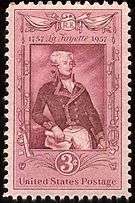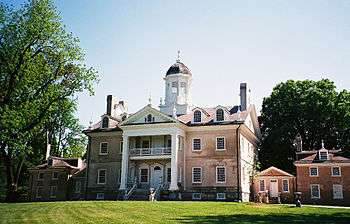Eliza Ridgely

Eliza Eichelberger Ridgely (February 10, 1803 – December 20, 1867) was an American heiress, traveler, arbiter of fashion, and mistress of Hampton, the Ridgely plantation north of Towson, Maryland. She is the Lady with a Harp of Thomas Sully's portrait, now in the National Gallery of Art, Washington, D.C.[1][2]
Background
Eliza Ridgely was the only child of Nicholas Greenbury Ridgely (1770–1829), a rich wine merchant of Baltimore, who married her mother, Elisabeth Eichelberger, on July 30, 1801.[3] Elizabeth had been born on December 6, 1783, at Baltimore, the daughter of Johann Martin Eichelberger and his wife Elizabeth Welsh,[4] and died on February 10, 1803, aged nineteen years and two months, a few hours after the birth of her only daughter.[3] Nicholas Ridgely died in 1829 and is buried in the cemetery at Hampton.[5]
Life

Eliza Ridgely was an heiress who became a foreign traveler and an arbiter of fashion.[6] She met and befriended the Marquis de Lafayette during his United States tour of 1824–1825 and stayed in contact with him for the rest of his life.[5] Some of his letters to her have survived, including an invitation to visit La Grange, his country estate in France—a visit which took place in 1834—and his congratulations on her marriage.[6]
On January 8, 1828, Eliza Ridgely married John Carnan Ridgely (1790–1867). He was the son of Charles Carnan Ridgely of Hampton Mansion, and his father had served as Governor of the state of Maryland from 1815 to 1818.[7]
John Carnan Ridgely was the grandson of John Carnan who married Achsah Ridgely. Achsah's brother, Charles Ridgely III (d. 1790), the builder of the Hampton plantation being childless as his end neared, willed that his sister's progeny should take the Ridgely name to inherit his vast estates. Thus, John Carnan Ridgely was, in fact, a fifth cousin of Eliza Eichelberger Ridgely.
On the death of Charles Carnan Ridgely in July 1829, his estate of some 25,000 acres (100 km2) was divided, John Carnan Ridgely inheriting the main house and 4,500 acres (18 km2).[7]
Eliza Ridgely thus became the third mistress of Hampton,[6] a great house which when built in 1790 had been the largest private residence in the United States.[8]
With John Carnan Ridgely, she had five children:
- Eliza Ridgely, b. October 28, 1828, who married firstly John Campbell White, becoming the mother of the diplomat Henry White, later marrying secondly Thomas H. Buckler.
- Charles Ridgely, b. March 22, 1830
- Priscilla Ridgely, b. December 21, 1831
- Nicholas Greenbury Ridgely, b. June 17, 1834
- Julia Maria Ridgely, b. March 16, 1841
Eliza Ridgely had a serious approach to financial affairs. The daughter of a merchant, she had married into a family which recorded the smallest transaction, and she kept careful accounts of all her expenditure, even noting the nine and a half cents she paid for a piece of ribbon. As well as her personal spending, her accounts also show her expenses in ensuring that the Hampton slaves were clothed and shod, a major undertaking.[9] She also recorded her subscriptions, such as those to the Baltimore Humane Impartial Society from 1849 to 1854 and her donations to a Widows Asylum between 1849 and 1851.[10]
Eliza Ridgely ordered church services for her slaves in the attic of the Hampton carriage house. The services were taken by a white minister, Mr Galbraith, until he was dismissed for marrying a woman believed to have African blood. Ridgely herself oversaw funerals and weddings in the house's great hall. One of Ridgely's grandsons, the diplomat Henry White, recalled that she "...was very particular in having what she was pleased to describe (and which I then believed to be) 'marriages', performed by a clergyman, between the negro servants, when so inclined: not realizing – certainly I did not at the time – that slaves were unable to perform any civil act, being mere chattels". Ridgely's daughter Eliza recorded having taught a group of slave children the Lord's Prayer.[9]
Eliza Ridgely was an avid gardener, and in the 1830s and 1840s she improved the gardens and enhanced the landscape at Hampton, planting exotic trees such as the Lebanon Cedar which still stands on the house's south lawn.[11] She is said to have brought this herself as a seedling from Europe, carrying it in a shoebox.[5] She and her husband bought furniture for the house which reflected the classical influences already indulged there.[12] In 1839, the landscape gardener Henry Winthrop Sargent found that Hampton's venerable appearance and foreign air "...quite disturb one's ideas of republican America".[12]
Lady with a Harp
Thomas Sully's painting Lady with a Harp (pictured) is a portrait of Eliza Ridgely done in 1818, when she was only fifteen, showing her wearing an Empire satin gown with a draped shawl as she plucks the strings of a pedal harp. It was commissioned by her father, Nicholas Greenbury Ridgely, who at the same time was himself painted by Sully.[5] Eliza really did play the harp, and her surviving bills and receipts include those for music lessons and for the repair of her harp in the years 1820 to 1826.[10] Whether her arms were as long and her figure as slender as they were painted is uncertain. Sully later commented on all his work "From long experience, I know that resemblance in a portrait is essential; but no fault will be found with the artist (at least by the sitter) if he improve the appearance."[2]
The painting was kept at Hampton from the 1820s until 1945, when it was sold to the National Gallery of Art.[13] After David Finley, director of the gallery, had acquired Lady with a Harp he became an advocate for the preservation of Hampton. He helped to arrange a deal under which the Ridgelys sold the house to Ailsa Mellon Bruce's Avalon Foundation, which in 1948 gave it to the National Park Service.[8]
There is now a copy of the painting at Hampton.[8]
Surviving papers of Eliza Ridgely
A number of financial records kept by Eliza Ridgely have been preserved:[1][10]
- Account book of expenses on trip to Europe (1833–1834)
- Servants Clothing Book, (1835–1854)
- Account Book (1838–1846)
- Accounts of Eliza E. R. Ridgely with her Trustees for her father's estate (1840s)
- House Accounts (1845)
- Accounts of Eliza E. R. Ridgely with her Trustees for Nicholas G. Ridgely's estate (1840s)
- Travel Account Book (1846–1847)
- Account Books (1849–1853)
- John & Eliza Ridgely, Farm Account Book (1850–1864)
- Account Book as Trustee to Nicholas G. Ridgely (1858–1867)
Other surviving manuscripts include letters Eliza Ridgely wrote to her daughter Eliza (known as 'Didy') between May 8 and July 12, 1858, a commonplace book of poetry she kept before her marriage, and letters she received from her friend Lafayette, her son Charles at Harvard and her daughter Eliza traveling in Europe.[1]
Bibliography
- Shipe, Bess Paterson, 'Eliza Eichelberger Ridgely, The Lady with a Harp', in Maryland Historical Magazine 77, no. 3 (Fall 1982) pp. 230–237
- Torcia, Robert Wilson, 'Eliza Ridgely and the Ideal of American Womanhood, 1787-1820' in Maryland Historical Magazine 90, no. 4 (Winter 1995) pp. 405–423
- Miller, Beth L., 'The Ridgelys of Hampton: New Perspectives on Musical Life in Early-Nineteenth-Century Baltimore' in Journal of Musicological Research 14 (1994) pp. 35–54
References
- 1 2 3 Comprehensive Guide to Collections: Eliza Eichelberger Ridgely Ridgely last revised December 4, 2007, online at nps.gov, web site of the National Park Service, accessed July 26, 2008
- 1 2 Lady with a Harp: Eliza Ridgely, 1818 at nga.gov, accessed July 26, 2008; as Ridgely was both her maiden name and her married name, she is sometimes called Eliza Eichelberger Ridgely Ridgely.
- 1 2 Eichelberger, A. W., Philip Frederick Eichelberger and his descendants 1693-1900 (Hanover Press, 1901) p. 21, quoting 'Church Records of St Paul's Parish', vol. 2, p. 6.
- ↑ Joh. Martin Eichelberger at rootsweb.ancestry.com, accessed July 26, 2008
- 1 2 3 4 Some Notable Ridgelys at nps.gov, web site of the National Park Service, accessed July 26, 2008
- 1 2 3 Hampton Highlights Volume 8, No. 1 - Fall 2006 at historichampton.org, accessed July 26, 2008
- 1 2 A Hampton Chronology Hampton National Historic Site (U.S. National Park Service July 2006)
- 1 2 3 Experience architectural greatness at Md.'s Hampton Mansion at usatoday.com, accessed July 26, 2008
- 1 2 Lancaster, R. Kent, 'Chattel Slavery at Hampton/Northampton, Baltimore County' in Maryland Historical Magazine, vol. 95, no. 4 (Winter 2000) online at Antebellum Plantation Life (see section headed 'chatelaine')
- 1 2 3 Ridgely Papers, 1664-1882, Maryland Historical Society at mdhs.org, accessed July 26, 2008
- ↑ Gutek, Gerald Lee & Patricia, Plantations and Outdoor Museums in America's Historic South (University of South Carolina Press, 1996, ISBN 1-57003-071-5)
- 1 2 A Palace in the Wilderness at nps.gov, accessed July 26, 2008
- ↑ Thomas Sully, American, 1783–1872, Lady with a Harp: Eliza Ridgely, 1818 at nga.gov, accessed July 26, 2008
